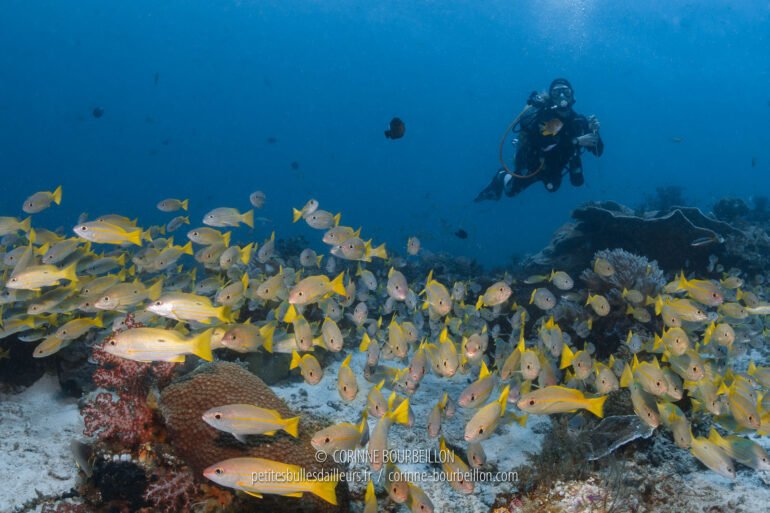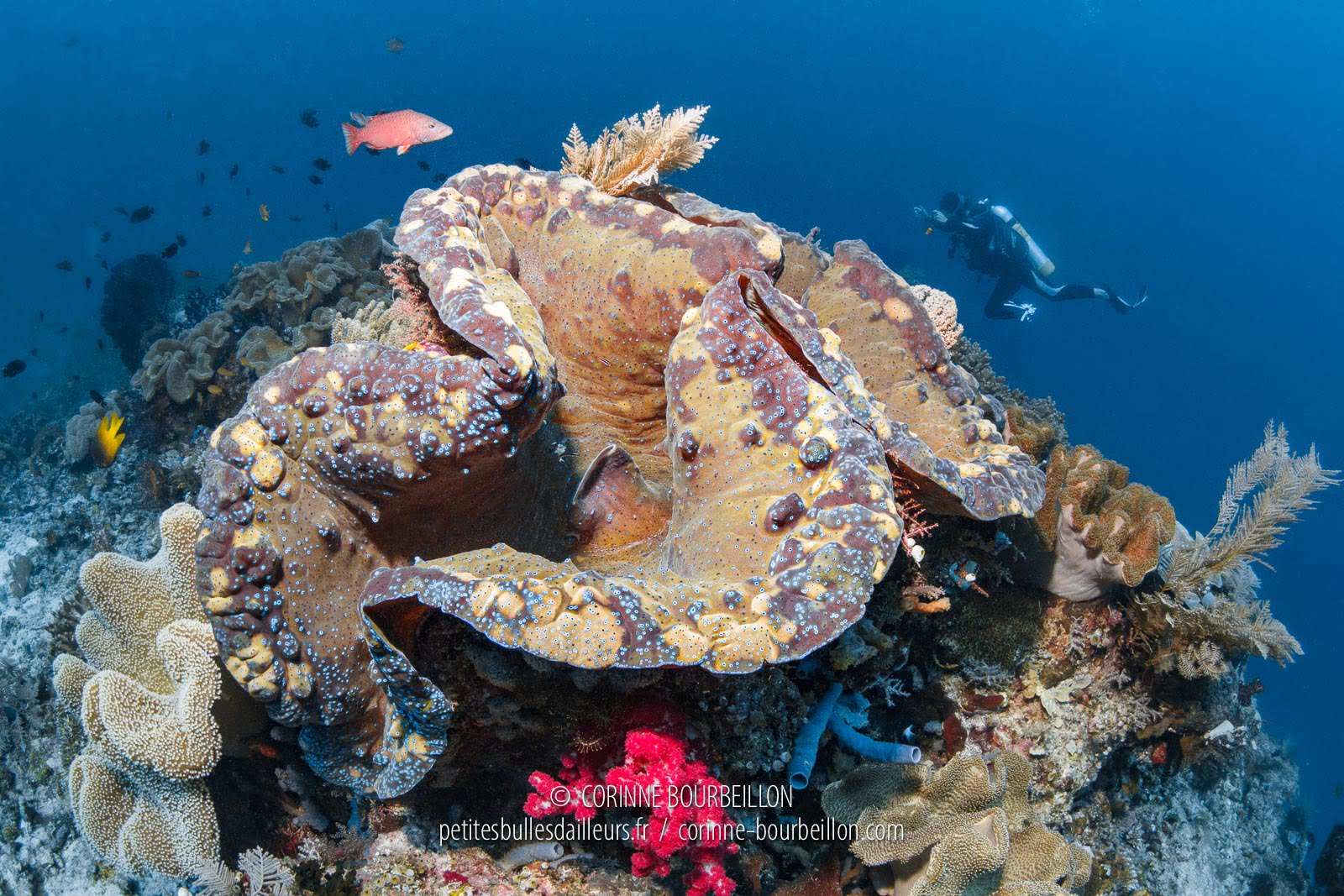Indonesia: Alor + Raja Ampat - July 2012
Dear English-speaking readers, this page is an automatic translation of an article originally written in French. I apologise for any strange sentences and funny mistakes that may have resulted. If you read French, click on the French flag below to access the original, correct text:
This big shell is a monster. Huge. It is not for nothing that it is called "giant clam". I have never seen one as big as this one in Raja Ampat.
The giant clams of Mioskon
Ah, Indonesia... I can't stop raving about the surprises that each new trip there brings me.
In July 2012, back in the archipelago of Raja AmpatEverything continues to amaze me. This is my second stay in these places (see the first one: in March 2012), but it's impossible to be jaded.
The small island of Mioskon, with its unusual cloud of bats above its cute white sand beach, conquered me.
Underwater, another curiosity awaits me: the biggest shell in the world... 😲
My friends Jimmy and Julia, from Sorido Bay Resortwho are accompanying me for this new dive, warned me: "Get your camera ready, they tell me in the Anglo-Saxon way (the term "camera" refers to anything that captures images, camera as well as video camera). You'll see, there are some beautiful clams!"
The giant clam, also called giant tridacne (Tridacna gigas of its scientific name), is a gigantic shellfish, which can measure up to 1,50 meter long and exceed 200 kg. It is the largest bivalve mollusc.
Yes, it can be eaten - the flesh of the shell is edible - but it is prohibited. The species is endangered and protected. It is quite common in the warm seas of the Indo-Pacific area.
Before this trip, it is probably at Pulau Wehon the other side of Indonesia, and also in Bali on the side ofAmedI had to see the biggest ones.
But here. Honestly. It surpasses all the giant clams I've ever seen before. It is huge! As always, in Raja Ampat, the "usual" tropical fauna is a notch above anything you can see elsewhere in Indonesia.
On the Mioskon site, there are several clams. But there is one very big one, much bigger than the others. Its yellowish-brown flesh pulsates, spilling out in big, fleshy, purplish lips over the shell. All of this in the middle of the coral, which is teeming with life, as always.

Update July 2016 : I returned to Raja Ampat, several years after this trip in July 2012. I went back to Mioskon, in particular in January 2015then in november 2015I was always looking forward to finding the big shell! Unfortunately, in July 2016, during a new trip to Raja Ampat, I discovered, stunned, that this beautiful and spectacular clam was dead. Gone was the throbbing purplish-brown flesh... Underwater, all that remains of the Mioskon clam today is a huge, empty, gray shell. Nobody knew what could have happened to it (illness, fishing). It made me a little sad, the disappearance of this giant shell... I consoled myself with other clams of nice size, on other sites, notably the one in Chicken Bay. I put a picture below.

Profusion
At Mioskon, when you get tired of staring at the clams, you can be mesmerized by the countless schools of yellowtail snappers that roll in and out of the shallow reef. There is also a good chance to see wobbegongsThose funny bearded shark-tapis that don't look at all like the terrifying things full of teeth that we see in some movies...
The one whose picture I took below "took off" from the reef without warning. I had not seen it!
I scared him and he ran away. But he ran straight towards me and I just had time to trigger my "camera", in a hurry.

Fortunately, I also have with me some cooperative human models, who deign to stop for a moment above the schools of fish...

In short, there's plenty to do, with all the junk coming from everywhere...
Profusion. This is the word that comes to me every time to talk about Raja Ampat.

Even the most "banal" site here is extraordinary for the abundance and variety of fauna that we encounter, for the colors and density of the coral.
No, really, nowhere else in Indonesia - except maybe some sites in Komodo - Neither in Malaysia nor in Thailand, I had this feeling of incredible profusion under water.
"Raja Ampat, where all the fish lives", like to say Max Ammera pioneer of diving in the archipelago. He is not wrong. All the fish live here!
At the end of the dive, at a shallow depth, I settle down in front of an imposing pink anemone, which shelters the "usual" clownfish.
I observe their carousel for a moment. There is a small family there, frightened by my arrival, huddling under the protective tentacles of its "home". It's been a long time since I photographed "Nemos"... I tend to disdain them during my dives, I have too many stored in my hard drives.
But this time, the beautiful velvety mauve of the anemone tempts me. Come on, one last one for the road!
➜ To see all the articles about my dives at Raja Ampat : one click here !






